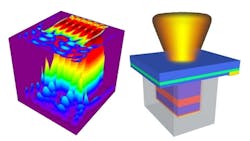Electrically powered nanolasers operate at room temperature
| Variations of light intensity within a nanolaser (left). A nanolaser with a metallic cavity (right), where the center red region confines electrons and the gray enclosure is a cavity of silver. The blue layer on top is the substrate on which the laser structure is grown. The orange-yellow cone indicates the light emission. (Image: Arizona State University) |
Phoenix, AZ--A research team at Arizona State University (ASU) led by Cun-Zheng Ning has created an electrically pumped continuous-wave nanolaser that reliably operates at room temperature.1 Previously, electrically powered nanoscale lasers have been able to operate effectively only in cold temperatures or have emitted only pulsed light. Researchers in the field have been striving to enable them to perform reliably at room temperature, a step that would pave the way for their use in a variety of practical applications.
Ning has been among engineers and scientists across the world attempting to fabricate a workable nanolaser with a volume smaller than its wavelength cubed -- an intermediate step toward further miniaturization of lasers.
Ning’s team started looking for solutions almost seven years ago, before he joined ASU, with his then-postdoctoral assistant, Alex Maslov, who is currently a scientist with Canon USA. While working at NASA's Ames Research Center, they proposed a semiconductor wire coated with a silver shell. They showed that such a core-shell structure was able to shrink the nanolaser.
About four years ago, working with Martin Hill, a former professor at Eindhoven University of Technology in the Netherlands, the team developed the thinnest nanolaser capable of operating at low temperatures. Two years ago, with the aid of Ning’s student, Kang Ding, they were able to raise the operating temperature to 260 K.
More recently the team demonstrated a device that could operate at room temperature, but the overheating led to imperfect device operation. These most recent results, however, demonstrated an eightfold improvement over previous results from a year ago, finally providing an unambiguous demonstration of continuous electrically driven operation of a laser at room temperature, Ning says.
“In terms of fundamental science, it shows for the first time that metal heating loss is not an insurmountable barrier for room-temperature operation of a metallic cavity nanolaser under electrical injection. For a long time, many doubted if such operation is even possible at all,” he says.
One potential use for nanolasers is as a building block in active metamaterials, which compensate (or more than compensate) for optical loss by emitting light in phase with that traveling in the metamaterial.
Remaining challenges
Ning says many challenges remain in efforts to integrate nanolasers into a photonic on-chip platform, as well as to prolong the lifetime of laser operation and to further develop the capabilities of such devices. In addition, the physical mechanisms involved in the interaction of photons with metallic structures on small scale are not yet fully understood.
REFERENCE:
1. K. Ding et al., Optics Express, Vol. 21, No. 4, p. 4728 (2013)
Source: https://asunews.asu.edu/20130311_ning_nanolaser_breakthrough
